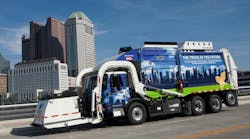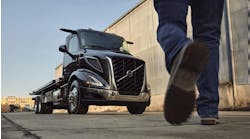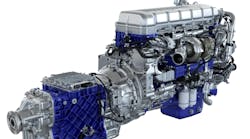Crossing the bridge to zero-emissions
The hybrid approach to electrifying trucks is sometimes seen as a bridge to trucks that are 100% ZE, or zero-emissions, all the time. There’s some truth to that. Long haul, in particular, could use mild hybrid systems for fuel economy gains while hydrogen technology and infrastructure mature. But it may also play a longer-term role in certain applications.
One possibility for hybrids is emissions reduction in vocational trucks, trucks that aren’t a good application for full electrification. A hybrid transmission — one that combines an electric motor/generator with a multi-speed automated transmission — could at low speeds provide ZE operation and eliminate torque breaks while reverting to diesel at higher speeds where NOx emissions are lower, according to Dr. Mihai Dorobantu of Eaton’s Vehicle Group.
Another possible application for hybrid technology could use a small displacement engine possibly running on natural gas or propane as an onboard generator for an electric drivetrain, Neandross said. A smaller engine wouldn’t need an active aftertreatment system.
The combination would also reduce the amount of fuel carried onboard as well as require fewer storage batteries, further reducing weight while increasing range and eliminating plug-in recharging. “That could optimize each piece of the puzzle to meet both operational and environmental requirements,” said Erik Neandross, CEO of the clean technology consulting group Gladstein, Neandross & Associates.
The bottom line is trucks will have many ways to reach zero emissions — or at least approach that absolute. Determining which path best fits a particular application will be complicated, but it’s far from impossible.
The far larger challenge is plotting a reliable timeline for that transition. The technologies are evolving along a steady predictable path, but there are a multitude of regulatory forces that make it difficult to predict when ZE will tip over into trucking’s mainstream.
In a recent study titled “Reinventing the Truck,” consulting firm IHS Markit proposed two scenarios on ZE adoption, with a timeline out to 2040. The market scenario, which it called the Rivalry model, looked at adoption driven by market conditions, and the Autonomy model considered a stricter regulatory environment.
Largely because diesel engines continue to make significant gains in fuel economy, electric trucks face an increasingly difficult total cost of ownership target, according to Matt Trentacosta, one of the study’s authors. In the Rivalry model, the study sees diesel remaining the dominant truck powertrain for some time, accounting for 66% of all new U.S. truck sales in 2040. However, that’s down from nearly 80% today as it forecasts the electric truck market share to grow at 15% a year.
Initially, the IHS market model sees medium-duty, plug-in trucks accounting for almost all of that growth as payload and range are less of an issue there, especially in Classes 4-5. Based on expectations of steady fuel efficiency improvements, diesel is expected to remain competitive with all alternative fuels, including electric in the long-haul heavy-duty segment. Because of the potential fuel efficiency benefits, some portion of that long-haul diesel market may include hybrid powertrains.
Fuel cells still have too many unknown costs to meet the diesel cost-of-ownership benchmark, but they could be expected to see higher adoption rates in the last decade of the study’s 2018 to 2040 market model, according to Trentacosta. Near-ZE with natural gas would also see some market-driven penetration in the short term as it performs well compared with diesel costs, he added.
The Autonomy scenario posits a far more aggressive approach from regulators aiming to force a shift from fossil fuels to non-carbon-producing alternatives. With some European cities and regions already proposing outright bans on diesels within city centers, this model sees more rapid adoption of ZE trucks in that market. Similar proposals are being considered in southern California and other areas in the United States, though they seem to favor incentives over bans. With regulation overruling TCO, the adoption rate for ZE is unclear under the Autonomy model, but it anticipates natural gas with its near-zero tailpipe emissions finding only small adoption rates.
While either scenario is plausible, it’s more likely that it will be rapid ZE technology improvements, in combination with regulation and incentives, that will drive the change to electric powertrains for trucks. That means a mix of technologies to match a variety of applications, with TCO motivating adoption of ZE for some fleets and regulation the deciding factor for others.
In either case, zero emissions are part of trucking’s future.
This week, we’re taking a deeper look at the future of ZE truck technologies. Read Part 1, Part 2 and Part 3 of this series.



